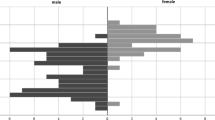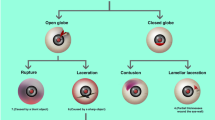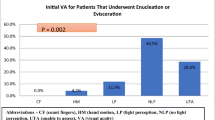Abstract
Purpose
To evaluate the demographic characteristics and visual outcomes of patients with open globe injury (OGI) in a tertiary hospital in Istanbul, Turkey.
Methods
The data of patients admitted with OGI to Sisli Hamidiye Etfal Training and Research Hospital, Istanbul, Turkey from January 2012 to December 2017 were reviewed retrospectively, and 100 of the 154 patients were included in the study.
Results
There were 79 (79%) male and 21 (21%) female patients with the average age of 33.7 ± 20.7 (1–83). Presentation of the patients was more frequent in the first 3 days of the week (Monday 20%; Tuesday 17%; and Wednesday 20%) and within working hours (8 a.m.–5 p.m., 71%). The most common injury type was penetrating injury (75%), which was mostly caused by sharp objects (metal objects 32% and broken glass 22.7%). The ocular trauma score (OTS) was significantly higher in patients with penetrating injury and intraocular foreign body injury (p < 0.001), and those results were correlated with better visual prognosis. The patients with penetrating injury among the injury types and zone I injury among the injury zones had the highest final visual acuity. Patients in the age group of 0–14 years had statistically better visual outcome when compared to those in the other age groups (p = 0.003).
Conclusions
The higher initial visual acuity and OTS, penetrating injury, zone I injury and pediatric age are good prognostic factors for OGI. Additionally, scheduling a prepared surgical team and tools in working hours will be beneficial according to the frequency of admissions.



Similar content being viewed by others
References
Kuhn F, Morris R, Witherspoon CD. Birmingham Eye Trauma Terminology (BETT): terminology and classification of mechanical eye injuries. Ophthalmol Clin North Am. 2002;15(2):139–43.
Negrel AD, Thylefors B. The global impact of eye injuries. Ophthalmic Epidemiol. 1998;5(3):143–69.
Soylu M, Sizmaz S, Cayli S. Eye injury (ocular trauma) in southern Turkey: epidemiology, ocular survival, and visual outcome. Int Ophthalmol. 2010;30(2):143–8.
Ji YR, Zhu DQ, Zhou HF, Fan XQ. Epidemiologic characteristics and outcomes of open globe injury in Shanghai. Int J Ophthalmol. 2017;10(8):1295–300.
Beshay N, Keay L, Dunn H, Kamalden TA, Hoskin AK, Watson SL. The epidemiology of open globe injuries presenting to a tertiary referral eye hospital in Australia. Injury. 2017;48(7):1348–54.
Karlson TA, Klein BE. The incidence of acute hospital-treated eye injuries. Arch Ophthalmol. 1986;104(10):1473–6.
McGwin G Jr, Xie A, Owsley C. Rate of eye injury in the United States. Arch Ophthalmol. 2005;123(7):970–6.
Liggett PE, Pince KJ, Barlow W, Ragen M, Ryan SJ. Ocular trauma in an urban population. Review of 1132 cases. Ophthalmology. 1990;97(5):581–4.
Pieramici DJ, MacCumber MW, Humayun MU, Marsh MJ, de Juan E Jr. Open-globe injury. Update on types of injuries and visual results. Ophthalmology. 1996;103(11):1798–803.
Rahman I, Maino A, Devadason D, Leatherbarrow B. Open globe injuries: factors predictive of poor outcome. Eye. 2006;20(12):1336–41.
Agrawal R, Ho SW, Teoh S. Pre-operative variables affecting final vision outcome with a critical review of ocular trauma classification for posterior open globe (zone III) injury. Indian J Ophthalmol. 2013;61(10):541–5.
Kuhn F, Maisiak R, Mann L, Mester V, Morris R, Witherspoon CD. The ocular trauma score (OTS). Ophthalmol Clin North Am. 2002;15(2):163–5 (vi).
Han IC, Puri S, Wang J, Sikder S. Impact of surgeon subspecialty training on surgical outcomes in open globe injuries. Clin Ophthalmol. 2015;9:1807–13.
Pieramici DJ, Sternberg P Jr, Aaberg TM, Sr., et al. A system for classifying mechanical injuries of the eye (globe). The Ocular Trauma Classification Group. Am J Ophthalmol. 1997;123(6):820–31.
Kuhn F, Morris R, Witherspoon CD, Heimann K, Jeffers JB, Treister G. A standardized classification of ocular trauma. Ophthalmology. 1996;103(2):240–3.
Schmidt GW, Broman AT, Hindman HB, Grant MP. Vision survival after open globe injury predicted by classification and regression tree analysis. Ophthalmology. 2008;115(1):202–9.
Kim JH, Yang SJ, Kim DS, Kim JG, Yoon YH. 14-year review of open globe injuries in an urban Korean population. J Trauma. 2007;62(3):746–9.
Cillino S, Casuccio A, Di Pace F, Pillitteri F, Cillino G. A 5-year retrospective study of the epidemiological characteristics and visual outcomes of patients hospitalized for ocular trauma in a Mediterranean area. BMC Ophthalmol. 2008;8:6.
Kivanc SA, Akova Budak B, Skrijelj E, Tok Cevik M. Demographic characteristics and clinical outcome of work-related open globe injuries in the most industrialised region of Turkey. Turk J Ophthalmol. 2017;47(1):18–23.
Kanoff JM, Turalba AV, Andreoli MT, Andreoli CM. Characteristics and outcomes of work-related open globe injuries. Am J Ophthalmol. 2010;150(2):265–9.e262.
Kong GY, Henderson RH, Sandhu SS, Essex RW, Allen PJ, Campbell WG. Wound-related complications and clinical outcomes following open globe injury repair. Clin Exp Ophthalmol. 2015;43(6):508–13.
Chee YE, Patel MM, Vavvas DG. Retinal detachment after open-globe injury. Int Ophthalmol Clin. 2013;53(4):79–92.
Meng Y, Yan H. Prognostic factors for open globe injuries and correlation of ocular trauma score in Tianjin, China. J Ophthalmol. 2015;2015:345764.
Smith AR, O’Hagan SB, Gole GA. Epidemiology of open- and closed-globe trauma presenting to Cairns Base Hospital, Queensland. Clin Exp Ophthalmol. 2006;34(3):252–9.
Soliman MM, Macky TA. Pattern of ocular trauma in Egypt. Graefes Arch Clin Exp Ophthalmol. 2008;246(2):205–12.
Yu Wai Man C, Steel D. Visual outcome after open globe injury: a comparison of two prognostic models—the ocular trauma score and the classification and regression tree. Eye. 2010;24(1):84–9.
Unver YB, Kapran Z, Acar N, Altan T. Ocular trauma score in open-globe injuries. J Trauma. 2009;66(4):1030–2.
Uysal Y, Mutlu FM, Sobaci G. Ocular trauma score in childhood open-globe injuries. J Trauma. 2008;65(6):1284–6.
Gunes A, Kalayc M, Genc O, Ozerturk Y. Characteristics of open globe injuries in preschool children. Pediatr Emerg Care. 2015;31(10):701–3.
Sahraravand A, Haavisto AK, Holopainen JM, Leivo T. Ocular trauma in the Finnish elderly—Helsinki Ocular Trauma Study. Acta Ophthalmol. 2018;96(6):616–22.
Funding
This research received no specific grant from any funding agency in the public, commercial, or not-for-profit sectors.
Author information
Authors and Affiliations
Corresponding author
Ethics declarations
Conflict of interest
The authors declare that there is no conflict of interest.
Rights and permissions
About this article
Cite this article
Ustaoglu, M., Karapapak, M., Tiryaki, S. et al. Demographic characteristics and visual outcomes of open globe injuries in a tertiary hospital in Istanbul, Turkey. Eur J Trauma Emerg Surg 46, 549–556 (2020). https://doi.org/10.1007/s00068-018-1060-2
Received:
Accepted:
Published:
Issue Date:
DOI: https://doi.org/10.1007/s00068-018-1060-2




